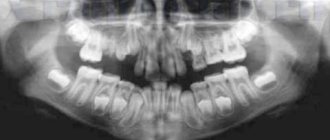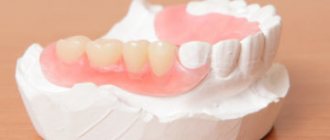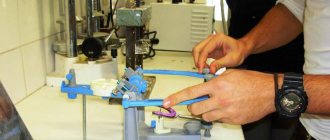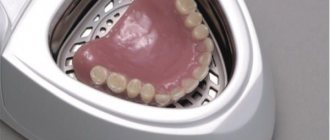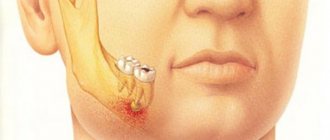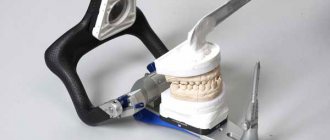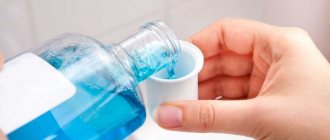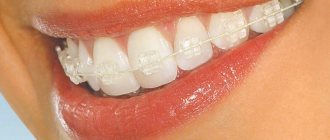A jaw fracture is classified as a serious injury.
It can cause facial distortion and disruption of chewing functions. Due to tissue tears in the mouth and damage to the teeth, the only option for recovery is splinting. A mandibular fracture is considered more serious. A patient with a jaw fracture is transferred to artificial feeding.
To quickly restore functions and bones, the patient’s diet should be carefully selected; it should be balanced and nutritious. Considering the impossibility of chewing, food should be of liquid consistency and optimal temperature.
What can you eat
If you have a tire, the ration is not very large. The patient is allowed milk, vegetable or meat broth as the main food. To replenish proteins, you can drink raw eggs. To provide fiber, crushed oatmeal is prescribed. When preparing soup, it is subsequently ground in a blender and given as a liquid puree. In addition, the patient can be offered:
- Compote.
- Kissel.
- Baby food mixtures and purees.
- Fermented milk products without solid particles.
- Vegetable and fruit juices.
- Ground porridge diluted with milk or broth.
When the splint is removed, you should return to your usual food gradually, avoiding increased stress on the jaw. To diversify the diet, vegetable purees, low-fat cottage cheese, cod liver, and chopped pasta are recommended. Gradually, food needs to be chopped less and less, and only when the patient can eat porridge and soups unchanged should one begin to add more solid foods.
Nutritional Features
Feeding a patient with a jaw fracture can be done in several ways:
- Oral. Possible with minor injuries, when the patient can open his mouth independently. This is the usual way for a healthy person using appropriate utensils.
- A sippy cup with a straw is required when bimaxillary fastening of fragments was carried out. The tube is attached to the gap on the line of missing teeth or near the wisdom tooth. Food intake is carried out gradually in a sitting position. Usually mixtures and pureed baby food are poured in.
- If using a sippy cup is impossible due to the complexity of the fracture, then a probe is used. The nurse inserts it into the lower nasal passage, then moves the device along the nasopharynx and through the esophagus into the stomach. Food is poured into the system through a syringe.
- Intravenous nutrition is indicated after surgery when the patient is unconscious or unable to swallow. Feeding is done 3 times a day.
- In some cases, nutritional enemas are given through a probe inserted anally into the intestines.
Depending on the choice of method, the patient is assigned table No. 1 or No. 2. The main difference lies in the variety of the menu and the consistency of the food.
- Table No. 1 involves probing, the energy value of the daily diet is 3200-4000 Kcal. The consistency is no thicker than liquid cream.
- Table No. 2 is prescribed when the patient’s mouth opening function is not impaired or during the transition period after removing the splints. The consistency is thick sour cream. Calorie content is set individually, based on the availability of mixtures and nutritious drinks in addition to the main diet.
Principles of nutrition
Eating food should not cause a negative reaction, otherwise the situation is fraught with refusal to eat. The patient needs to present the conditions as a forced necessity, but do it in a gentle form, supporting and approving all attempts at self-care.
Regardless of the presence of a splint and the form of treatment for a jaw fracture, a number of rules should be followed:
- Nutrition should be balanced, contain the necessary vitamins, minerals, amino acids, proteins, fats and carbohydrates in the required volume.
- To increase the nutritional value, grated dishes with a thicker consistency than required are diluted not with water, but with broth or milk.
- To replenish carbohydrates, you need to eat high-quality pasta.
- Vegetable oil should be added to already prepared dishes.
- The temperature of the food must be acceptable for the patient, since if there is a splint, he does not have the opportunity to further cool the food and may get burned.
- You need to eat at least 5-6 times a day.
- Meals should be fractional.
- The food should be ground so that there are no particles larger than grains of semolina.
- To normalize peristalsis, do not forget about fiber. It is found in large quantities in buckwheat and oatmeal.
- Fiber is also found in vegetables. You need to eat beets, potatoes, carrots, cabbage, tomatoes, boiled and pureed.
- You can get the necessary vitamins by consuming freshly squeezed vegetable and fruit juices.
The dental cavity during this period is very susceptible to infection as it does not receive the necessary cleaning. To avoid complications, all products must be thoroughly washed and cooked. In addition, after each meal you need to rinse your mouth with special cleansing liquids.
First aid
A broken jaw causes serious harm to health. Pre-medical intervention should be immediate.
First aid for a broken jaw is as follows:
- Stop bleeding. A tampon made from a clean napkin should be pressed onto the wound. If blood continues to flow, an ice compress should be applied to the fracture site.
- Anesthesia. It is allowed to inject the patient with 500 mg of Analgin, 750 mg of Naproxen, or 1-2 ml of Revalgin.
- Immobilization of the jaw. To do this, you can use a ruler or a plate. You can secure a homemade splint using a sling bandage.
Note! If necessary, the patient is given cardiopulmonary resuscitation. After providing first aid, you need to call an ambulance or transport the victim yourself to the hospital. Further treatment is carried out in a hospital.
What does a doctor do
Therapy consists of the following:
- combination of jaw bone fragments;
- fixation of debris using a special tire;
- creating optimal conditions at the site of injury for bone restoration;
- carrying out restorative, antimicrobial and preventive treatment.
If necessary, the doctor performs surgery. If the destruction of the jaw bone leads to facial injury, complex plastic surgery is performed. During the operation, jaw and facial prostheses are used.
Food for the period of splinting
Outpatient treatment during the splinting period imposes a number of restrictions on the patient’s nutrition. It can be used:
- Broth and soup based on meat broth with grated cheese. Juices without pulp.
- Uzvars, fruit drinks, compotes.
- Not thick jelly.
- Kefir, fermented baked milk.
- Liquid mixtures.
Whole milk can increase the viscosity of saliva, so it is not drunk in its pure form, but used as an additive to tea or vegetable dishes and cereals.
Sample menu for the week
The patient should receive a sufficient amount of vitamins and minerals within a week. The sign shows a sample menu. It can be varied according to your own taste.
Table 15. Sample weekly menu:
| Day of the week | Breakfast | Lunch | Dinner | Afternoon snack | Dinner |
| Monday | 200 grams of oatmeal cooked with milk, a cup of tea with milk. | 1 egg, applesauce. | A bowl of bone broth soup, vegetable puree, a glass of tomato juice. | Any boiled fish, pea puree | Broccoli, fresh vegetables, a glass of carrot juice. |
| Tuesday | Millet porridge boiled in milk, a glass of apple juice. | Any fruit. | Fish soup with cheese, broccoli. | Cottage cheese, a glass of kefir | Vegetable puree, 150 grams of rabbit meat, a cup of green tea. |
| Wednesday | Corn porridge, boiled in milk and seasoned with a piece of butter, a cup of tea. | Berry mousse. | Vegetable soup cooked in beef broth, 150 grams of meat, any vegetables. | Carrot puree, a cup of green tea. | Boiled fish, Brussels sprouts. |
| Thursday | Oatmeal with milk, 100 grams of cheese. | Creamy dessert. | Chicken broth, 150 grams of any meat, pea puree. | Applesauce, a glass of freshly squeezed juice. | 200 grams of cod, rice. |
| Friday | Buckwheat porridge, a cup of tea with cream. | Pear puree, a glass of freshly squeezed juice. | Pea soup, 200 grams of beef, mashed potatoes, a glass of vegetable juice. | Berry mousse, 1 glass of jelly. | Vegetable puree, 200 grams of crab meat. |
| Saturday | Corn porridge boiled in milk, 100 grams of any cheese, a cup of coffee with milk. | 1 banana, a glass of freshly squeezed berry juice. | Soup with any cereal, 200 grams of carp, any pasta. | 200 grams of cottage cheese. | Rabbit meat, broccoli. |
| Sunday | Lentil porridge cooked in milk, a cup of green tea. | Applesauce. | Tomato soup, 200 grams of any meat, mashed potatoes. | 100 grams of Dutch cheese, a glass of tomato juice, berry mousse. | Rice, 200 grams of boiled cod. |
Recovery period
The rehabilitation period for patients with a fracture of the lower jaw lasts 1-2 months. After removing the tire, all acceptable dishes remain and curds, vegetable puree, and cod liver are added. Next, raw fruits are gradually introduced, and at the very end, crackers and nuts.
It is very important to enrich the diet with zinc, phosphorus, and calcium. The daily norm of ground and diluted meat is at least 150 g.
Use of enteral formulas
Such mixtures contain everything necessary for the patient’s complete nutrition and are well absorbed. Among the variety of market representatives, the production of these products is carried out by Nutridrink, Nutrizon, Nutrilon, Forticare. The mixtures are liquid and dry for further dilution. The former are much more convenient, but more expensive.
If the patient is not bothered by problems with the digestive system, then the Nutridrink line is the ideal choice. A bottled mixture with different flavors allows you to diversify the patient’s meager diet, thereby increasing his appetite. If the patient does not like supplements, then a neutral type of nutrient solutions will suit him, especially since it is suitable even for people with lactose intolerance.
Nutrilon has proven itself by using the innovative “Immunofortis” system in the production of mixtures, this allows the introduction of especially fatty acids into the composition. To try out the product, you can purchase a 400 g jar, and for long-term use they produce 900 g containers. For patients with lactose intolerance, there is lactose-free Nutrilon. Comfort immunofortis was developed to prevent constipation. Fermented milk Nutrilon helps normalize the functioning of the gastrointestinal tract.
Baby formula does not stay in the mouth for long and is easily washed out with special solutions.
Nutrizon contains a large amount of protein; in 100 g of the finished product its content is 4 g. In turn, fat is 3.9, and carbohydrates are 12.3 g. The line includes the usual mixture and Nutrizon Energy, which contains the necessary dietary fiber.
What to do if your jaw crunches and clicks
A crunching sound in the jaw when chewing or talking is just a symptom that may indicate various diseases. The most common reasons are:
- Pathologies of the mandibular joint:
- Dislocation, especially bilateral, when you open your mouth and cannot close it.
- Subluxation, in which there is joint fatigue due to standing with the mouth open for a long time.
- Arthrosis and arthritis after purulent forms of oral diseases: tonsillitis, tuberculosis, gonorrhea.
- Inflammation on the right or left side of the temporomandibular joint.
- Cartilage wear.
- Any other dysfunction that makes chewing difficult.
- Decreased muscle tone:
- Spasm of the jaw muscles on the right or left, for example, as a result of severe stress and overexertion.
- Trismus is excessive muscle tension during daily activities.
- Dental problems:
- Multiple caries - dilapidated teeth violate the height of the bite and lead to its displacement; the jaw withstood the load for some time, and then cracked for the first time.
- Old or poorly fitting metal dentures.
- Mesial bite, jaw creaks until it is straightened.
- Poor quality filling without taking into account anatomical features.
- Removal of wisdom teeth.
- Other problems:
- Involuntary teeth grinding – bruxism.
- Features of the structure of the jaw joints and ligaments.
- Connective tissue dysplasia.
- Tonsillitis.
- Diseases of the facial nerves, for example, trigeminal neuralgia.
- Any maxillofacial injuries. They are usually the general reason why the jaw clicks when opening and closing the mouth.
Jaw arthritis
This disease develops as a result of the pathogenic action of microbes. Due to their vital activity, the meniscus becomes thinner or swollen, the tissue fibers become loose, and the articular head itself begins to fuse with the cartilage. This is caused by the accumulation of large amounts of pus in the tissues due to complications of infectious diseases and inflammatory processes after injuries.
If a person’s jaw hurts and clicks even with slight movement, it is visually displaced and swollen, then this may indicate developing arthritis. You should not wait for an increase in temperature, deterioration in hearing due to the development of a purulent form and other serious symptoms; you must immediately visit an orthodontist or maxillofacial surgeon.
We suggest you read: Primary syphilis in the oral cavity
Mesial bite
Jaw problems can occur due to a malocclusion, when the lower jaw is pushed forward and the lower front teeth cover the upper row. Most often, the problem can be eliminated by installing braces, but everything is individual.
Neuralgia
Nerve damage often causes characteristic pain. There are neuralgia:
- Trigeminal nerve. The lesion is unilateral, so the joint in the jaw clicks and clicks only on the right or left side, the pain worsens at night.
- Glossopharyngeal nerve. Symptoms include painful attacks with increased salivation, which intensifies when talking and eating.
- Superior laryngeal nerve. The pain is localized in the lower jaw, but can spread to the entire face or chest, and is activated during the process of yawning, chewing and blowing the nose.
Injuries
After mechanical damage, the jaw often knocks and crunches when opening the mouth. If these clicks are accompanied by pain, then its intensity is directly proportional to the severity of the injury. The following damages are distinguished:
- Soft tissue bruise without bone fracture. Accompanied by swelling around the affected area, bruising and acute pain.
- Fracture. Symptoms: loss of integrity, displacement of parts of the jaw, swelling near the site of impact and severe pain when closing the mouth.
- Dislocations. Most often, such injuries occur in patients with gout, arthritis, and rheumatism. There are habitual and acute dislocations. The former arise due to problems with the activity of the articular apparatus, the latter must be treated by restricting mobility through orthodontic fixation.
Some diseases that cause jaw clicking have hereditary causes. DST is a pathology of the development of connective tissue of the embryo and infant, leading to disruption of homeostasis at all levels of the body, including the temporomandibular joints.
Tonsillitis
Inflammatory processes, including in vegetative form, in the tonsils and adenoids can cause the jaw to crack. Characteristic sounds occur when the tonsils are greatly enlarged, when swallowing becomes difficult. The most effective option in this case is to perform a tonsillectomy.
Treatment is prescribed based on the diagnosis. In some cases, medication will not be required, but in others, urgent hospitalization will be indicated. In the presence of inflammatory processes, antibiotics are prescribed.
We suggest you familiarize yourself with: Position of teeth in the lower jaw
Painful sensations that often accompany jaw clicking can be eliminated with the help of analgesics, but only as directed by a doctor:
- Ketanol.
- Ibuprofen.
- Analgin.
The use of glucocorticosteroids is justified for the treatment of arthritis. They help to quickly stop the inflammatory process by suppressing the immune response. Such drugs include:
- Prednisolone.
- Hydrocortisone.
- Medrol.
To restore cartilage tissue, various chondroprotectors are used, for example, Teraflex and Chondroitin.
Physiotherapy
Physiotherapeutic procedures are classified as conservative methods of treatment. They help with muscle-joint dysfunctions and jaw diseases. The following methods of such therapy are distinguished:
- Fluctuarization in the area of the masticatory muscles. Has an analgesic effect.
- Anti-inflammatory microwave radiation on the joint.
- Infrared laser magnetic therapy. Relevant if the jaw is already wedged, it restores the acid-base balance.
- Electrophoresis with drugs, which reduces the inflammatory process, improves tissue metabolism and blood supply. The most commonly used drugs are novocaine or dimexide.
In case of serious injuries and pathogenic formations, surgical intervention is indicated for patients:
- Invasive. A medicinal substance is injected into the joint under pressure using two needles, thereby washing out harmful microorganisms and healing the tissue.
- Arthroscopy. Targeted removal of scars and adhesions through surgical punctures with a scalpel.
- Open operations. Replacement of the inflamed parts of the joint is carried out through an incision in front or behind the auricle.
- Articular head prosthetics.
- Retroaricular technique. Fixation of the joint with special internal screws.
Recommended vitamins
Mixtures rich in vitamins and minerals cannot replace good nutrition, so they must be introduced externally, especially in the warm season. A patient with a jaw fracture necessarily requires magnesium, zinc, calcium, phosphorus, vitamins C, D, K, and group B.
Vitamins b1 b6 b12
B1 is otherwise called thiamine. It is not characterized by accumulation and therefore must be present in full every day. For men, 1.6-2.5 mg per day is enough, for women – 1.5-2.4 mg, in childhood, 1.6-1.7 mg is enough. The largest amount of the substance is in lentils, oatmeal, millet, and buckwheat. There is a little less of it in buckwheat and liver. In general, indicators reach from 0.3 to 0.5 mg per 100 g of product.
B6 or pyridoxine is found in products of plant and animal origin, namely beans, tuna, sea buckthorn, sardines, mackerel, sweet pepper from 0.5 to 0.9 mg per 100 g. It is well synthesized and easily excreted. Magnesium promotes good absorption; with its deficiency, the process is disrupted.
B12 or cyanocobalamin is especially effective for anemia. It should be consumed in a volume of 3 mcg per day. There is a lot of it in octopus - 20 mg per 100 g. In rabbit - 4.3 mg, in sea bass - 2.4 mg. There is slightly less of it in pork, cod, carp, hard Dutch cheese, crabs, eggs, and sour cream.
Vitamin c
The daily intake of ascorbic acid for an adult should be 70-100 mg. Most of it is in rose hips - 1000 mg per 100 g. Significantly less in kiwi, black currants, Brussels sprouts, broccoli - from 90 to 200 mg. Orange, strawberry and cauliflower contain 60 mg per 100 g.
Vitamin d
Necessary for improving bone growth, it controls calcium-phosphorus metabolism. Adults need up to 10 mcg daily, children up to 15 mcg, and older people more than 16 mcg. You can find vitamin D in sour cream, butter, liver, perch, and eggs.
Vitamin k
Helps in the construction of bone structure, is responsible for the functioning of blood vessels, and in large quantities increases coagulation. 0.3 mg per day is required. There is a lot of it in greens: lettuce, spinach, onions. You can also find the vitamin in carrots, cucumbers, tomatoes, pears, bananas, and apples.
Products with magnesium
Magnesium is needed for healthy teeth, bones, and nails. You need to consume 450-500 mg per day. The element can be found in soybeans, seaweed, peas, and unpolished rice.
Products with calcium
This element is a building material for bone and dental tissue.
With its deficiency, fragility increases and there is a predisposition to fractures. Healthy young patients need at least 800-1000 mg per day, and elderly patients need about 1200 mg. At the same time, we should not forget that calcium relative to magnesium should be supplied in a ratio of 1:0.6. Products rich in calcium: processed cheese - 750-1000 mg per 100 g, feta cheese - about 625 mg, cottage cheese - 155 mg, cream - 85 mg.
Proper nutrition for a jaw fracture helps speed up the patient's recovery by delivering all the necessary vitamins, minerals and amino acids. Do not forget that food must be thoroughly chopped and warm. It is in this form that it will be safely delivered to its destination and absorbed in full.
If you find an error, please select a piece of text and press Ctrl+Enter. We will definitely fix it, and you will get + to karma
Vitamin complexes for fractures
Taking vitamin complexes for fractures is necessary to support the recovery process in bone tissue and increase bone strength.
Experts recommend the following drugs:
- Cadium D3 Nycomed and Kalcemin . These vitamin complexes help replenish the lack of calcium in the body, and vitamin D3 promotes better absorption and is a necessary component in the process of forming the collagen structure of bones.
- Collagen Ultra . This complex includes: calcium; retinol; ascorbic acid; biotin. These substances help speed up the process of bone healing and callus formation, and also help reduce the risk of new fractures.
- Osteo Sanum . This complex contains substances necessary to strengthen bones, namely: vitamins D3, B6 and B12; calcium; folic acid; mumiyo extract. The complex helps accelerate bone fusion and promotes a speedy recovery.
- Vitrum Osteomag . Replenishes the body with calcium, magnesium and vitamin D3 and is designed to increase the strength of bone tissue.
- EngoyNT . The drug not only eliminates bone fragility, but also helps relieve inflammation and pain.
The use of vitamin complexes is an integral part of therapy for bone fractures.
But in addition to taking medications, it is important to correctly formulate the patient’s diet and fill it with all the elements necessary for the regeneration process. If there is a lack of necessary substances in the body, this may cause slow bone healing.

